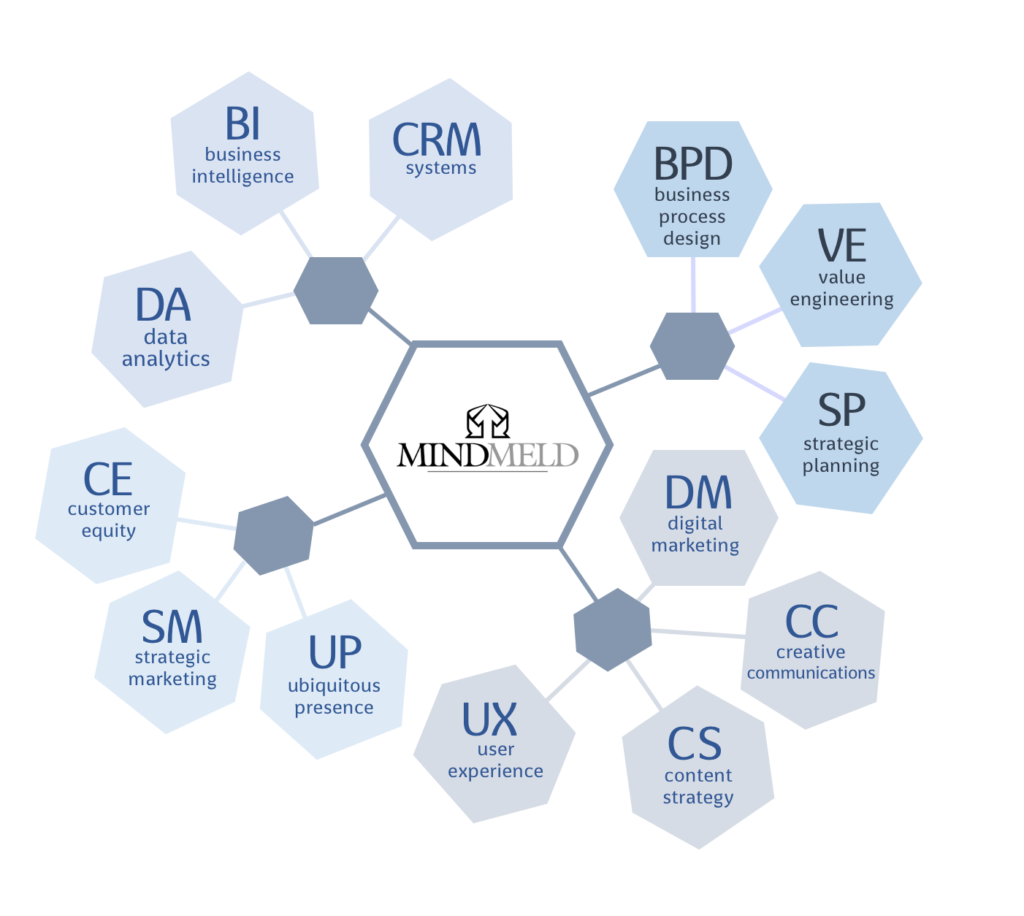Create Focus. Enable Sales. Fuel Growth. Delight Clients.


99% of Business Decision Makers (BDMs) agree that innovation and transformation — including digital technology related to services and apps — are mission critical for business performance improvement and sustained growth.
Unfortunately, research on organizational transformation published by McKinsey reveals overall success rates well below 30%. When the initiative is digital-related that number sinks to 16%. And of those that report some success, a mere 7% found they were able to sustain any performance improvements.
Talk about pressure. No wonder business leaders feel like they have to be doing 100 things at once. But the “one-man band” paradigm won’t cut it when it comes to effective, sustainable business transformation and/or innovation.
MindMeld provides a framework for integrating people, process, and products — beginning with your client and/or customer and their specific behaviors, needs, and requirements. In this way your valuable resources are focused on actions that optimize Lifetime Value of client relationships. We call it Taking AIM.
Our service delivery revolves around the AIM framework. Ideally you will engage MindMeld for end-to-end value chain optimization. But the fluid nature of the AIM framework allows for MindMeld services to be of great value whether you require brand definition and positioning, creative communications and content strategies or analytics and business process improvement (BPI).
No matter where you are in your
Organization Lifecycle, MindMeld service offerings
facilitate consistent, continuously improving performance while optimizing Brand Asset Value
brand, business and go-to-market strategy formulation

- Express your vision in simple, uncomplicated terms. Typically we start by trying defining the core value of what you do — and what clients will experience — using only a noun and a verb.
- Define your organization’s worldview. Start with a statement of purpose: we believe…
- Enumerate and describe your values. Be honest not obvious. What are the real values, not platitudes that sound good. Then define those terms as they relate to your business/brand.
- Detail methodologies. How will you deliver your core value (use of a Value Chain Analyzer is particularly useful).
- Construct a working growth model for the entire business/brand/ product/service lifecycle. Provide detail on how you will deal with major inflection points along the way.
- Perform a competitive analysis. You don’t need (or want) to focus on or necessarily respond to what the competition is doing, but you better be aware of what threats it represents.
- Complete a comprehensive Client Equity Model. This will help you understand the true value of a client relationship and how to optimize that value while targeting “look alike” clients.
creative communications, content management & value engineering

- Forget about, avoid, and do not even consider Management By Objective as a viable means of goal-setting and defining desired business outcomes. MBO is designed to fail.
- Use your Value Chain Analysis to map-out the client journey.
- Optimize resources based on customer/client point-of-view, NOT what works best for internal purposes.
- Define a Go-To-Market strategy based on the Vision/Mission, Worldview, Values, and Methodologies developed in the Analysis phase.
- Design, develop, and deploy a Creative Communications and Content strategy for sharing Value.
- Value Engineer processes, methodologies, content, and GTM.
- Tie team member performance metrics to your enumerated Values using both qualitative and quantitative measures.
analytics and business
process innovation
- Define what needs to be measured, who will do the measuring, and how metrics will be gathered, shared, and reported. Only measure what matters.
- Maintain FOCUS by keeping your simplified value proposition top-of-mind with customers/clients, channel partners, and team members.
- Be consistent. Consistency in messaging and the way you do things is far more important than any other aspect of business building.
- Recalibrate and fine-tune based on what you learn from the measurements in place. But make sure you have adequate data to review before acting. Otherwise you will destroy any shot at consistency.
- Remember, remind, emphasize, and reemphasize your organization exists to SERVE your customers and clients, not be served.

Take away brand asset value
and Coke's bottle is half empty.

Or is it half full? You make the call.
Either way, when your ultimate goal is creating, nurturing, and realizing optimum value from your business — maximizing Brand Asset Value is paramount.
Coke is a classic example. Without its market leading Brand Equity of nearly $70 billion Coke would be half as refreshing. And a lot less effervescent. Same goes for your business. If you aren’t building strong and enduring Brand Asset Value you are missing out on a lot of realized value.
Properly positioned, managed and promoted brands influence customer choice and cement loyalty, streamline and lower the cost of customer acquisition and retention, optimize lifetime value of client relationships, attract and motivate top talent and in many cases lower the overall cost of doing business. All of which increase the realized value of your organization.
Mindmeld guides you and your leadership team through a process for discovering, communicating and capitalizing on the inherent value and drama your company embodies. Optimizing Brand Asset Value over the entire organization lifecycle.
CXO-as-a-Service

There are times in every organization’s lifecycle when the leadership team either lacks the adequate talent, skills, and professional expertise necessary for optimum performance or just needs temporary augmentation. MindMeld founder and Chief Collaboration Officer — Doug Knuth — excels in specialized engagements where his analytical, creative, and process-driven core competencies focus the business, accelerate growth, and produce systems for continuous improvement.
